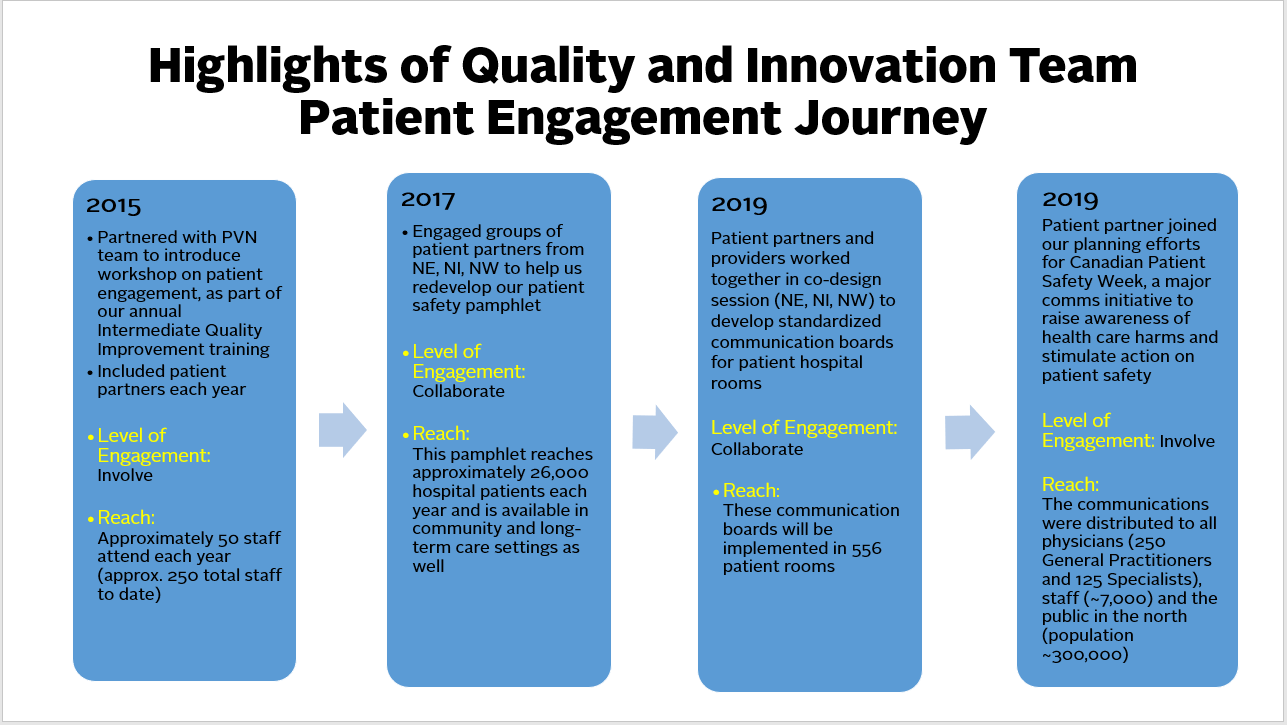Posted • Last updated
Categories: Improving Health Care, Patient Voice Mail, Working Together for Better Health Care
Northern Health is learning and growing in its capacity to engage with patient partners. In this blog post, we reflect on our patient engagement experiences with PVN and share key lessons learned. We are pleased with the developments that have occurred and look forward to continuing to grow our collaboration with PVN, and engagement efforts in the future.
Our Patient Engagement Journey
In the last five years, we are proud to say we have increased our engagements with patients as collaborators in face-to-face gatherings and as members of improvement teams.

Patient Partners as Educators. Beginning in 2015, we began to more actively partner with our PVN leads, Cathy Almost and Anthony Gagne and introduced a workshop to engage patient partners in our annual quality improvement training. Patient partners have been active participants in sharing their stories and helping us learn about how to authentically engage with them.
With a patient partner, we have developed an online training module to advocate for patients and family members as partners in their care. This has been designed as an avatar-type movie that shows her family story. It is available to our staff on the Learning Hub. We used the same patient story for the foundation of an in-person physician training event on patient journey mapping. Including patient partners has grounded these education opportunities in reality, underscoring the importance of making real change that profoundly impacts patients and their families.
Patient Partners as Co-Designers. Patients have been partners in several Northern Health efforts to improve patient-provider communication, as shown in the graphic above. It has become more of a usual way of working to include patients in our efforts and we continue to encourage others to make it a routine way of working. For example, our communications team needed to develop another pamphlet for all patients in hospitals, and with our encouragement, they included patients and providers in sessions to create this new communication tool.
Our Lessons Learned
Apart from learning that patients have very different and sometimes similar, perspectives as health care providers, one of our key learnings is that engagement and partnerships take time. This time to build relationships and include patients in all that we do to design, evaluate and educate, is well worth the investment. Providers need to take the time to include patients in their efforts, and patients need to be truly be patient with the sometimes slow pace of health care improvement. (The title “patient” is apparently for a reason!) That is not to say some improvements can’t be made quickly. For example, with an extraordinary effort, patients (including Indigenous voices) gave their input on an infographic designed to have empathetic conversations with family members during COVID-19. This document has been adopted by the NH Palliative care team for use.
Thank you!
As Quality Improvement Leads representing our Health Service Delivery Areas (Northwest, Northern Interior), we have had the privilege of supporting staff and physicians to include patients as partners in a wide range of efforts to improve care for Northerners. We’d like to thank each of our patient and provider partners for the opportunity to work with you. We appreciate your time, energy and contributions, and we look forward to working alongside you in the future.
Author: Jeanette Foreman & Marlene Apolczer

